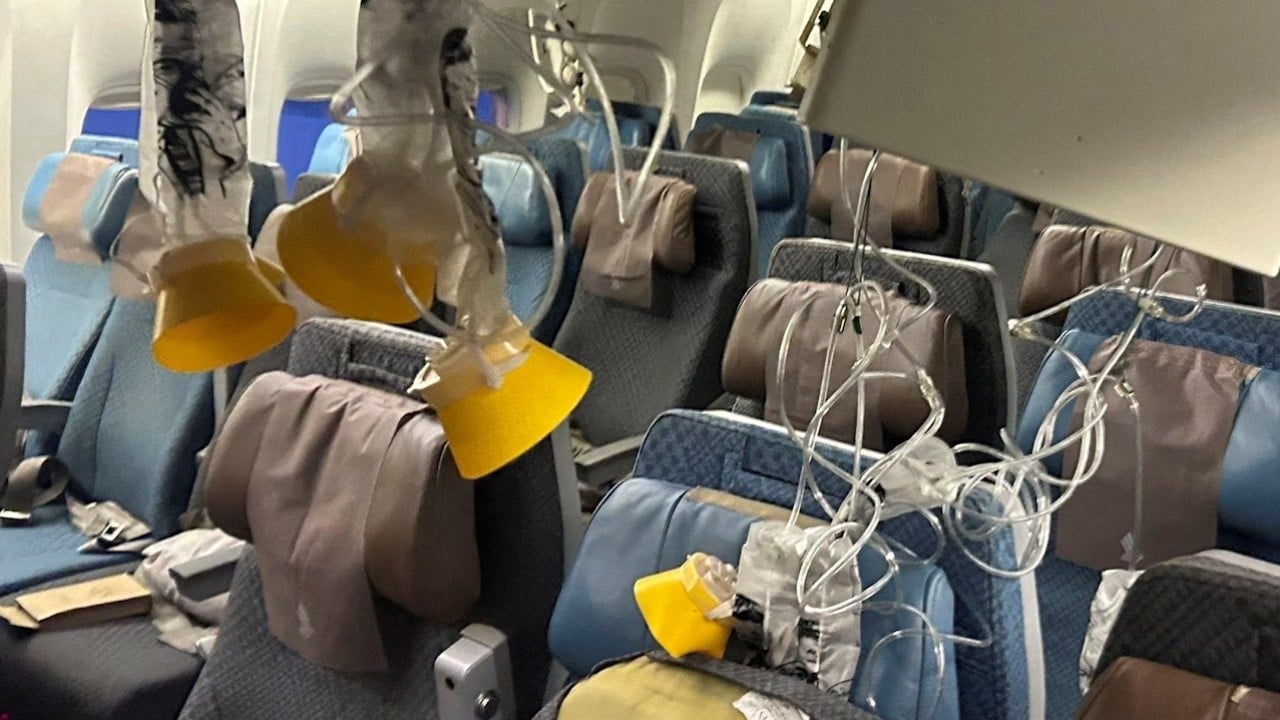
Singapore Airlines flight SQ321 passenger recalls turbulence chaos: ‘I thought the plane was going down’
- ‘The seat belt light came on and almost immediately after the turbulence hit, I myself, followed by a large amount of others, were thrown in the air hitting the roof,’ the British tourist said
- A man died and dozens were injured after the aircraft encountered severe turbulence and made an emergency landing in Bangkok
One moment Toby Pearl was ensconced in his economy-class seat in row 43 aboard a flight from London to Singapore. The next all hell broke loose, with personal belongings, food and even people being hurled around the cabin, crashing into overhead lockers and causing oxygen masks to deploy from the ceiling.
“The seat belt light came on and almost immediately after the turbulence hit, I myself, followed by a large amount of others, were thrown in the air hitting the roof,” Pearl said in response to written questions after the aircraft made an emergency landing in Bangkok. “It felt like we had crashed, I thought the plane was going down. You could hear the smashing of glass in the back of the cabin.”
Cruising at an altitude of 37,000 feet (11,200m) and with a good two hours left before the aircraft was due to touch down in Singapore, the twin-aisle plane was suddenly and forcefully shaken by what Pearl described as a “big hit” that took everyone off guard, followed by a smaller, “more manageable” impact.
The aircraft swiftly began an emergency diversion into Bangkok, according to data by flight tracking service Flightradar24. Emergency crews said seven people were critically injured and admitted to hospital. Others, including Pearl, received medical check-ups and complementary helpings of hamburgers before being cleared for their onward journey.
About 240 events of severe turbulence were reported to European planemaker Airbus between 2014 and 2018. Injuries to passengers and crew occurred on 30 per cent of long-haul flights where such events were reported, and 12 per cent of short-haul flights, according to a briefing document on the phenomenon.
Airlines advise passengers to keep their seat belts fastened at all times, though many people unbuckle once the pilot turns off the signs to make themselves comfortable on long journeys.
“More than 75 per cent of these injuries related to turbulence happen at high altitude more than 30,000 feet, at these altitudes you get clear air turbulence that is unpredictable,” said Hassan Shahidi, the CEO of the Flight Safety Foundation. “The aircraft is designed to withstand these kinds of shocks, but when you have passengers not wearing seat belts they are not protected.”
Flight SQ321 took off from London Heathrow at 10:38pm (local time) on May 20 on what should have been an uneventful 13-hour flight to Singapore’s Changi airport. The airline flies the route from London four times a day, twice using the Boeing 777, and twice with the Airbus A380 super jumbo. At 56 travellers, the biggest group of passengers was from Australia, followed by 47 from the UK and 41 from Singapore, according to the airline.
The aircraft overflew eastern Europe, and then crossed the Black Sea into Georgia and towards Tajikistan, taking the narrow corridor that airlines now use to avoid Russian and Iranian airspace. The Boeing then bore south and crossed the Indian subcontinent.
Investigators will likely look at the timeline and flight data after the plane crossed the Bay of Bengal into Myanmar and onwards into Thailand to determine what went wrong. Just as the jet was over Myanmar, data on FlightRadar24 shows the plane bumping up and down before settling back at its previous cruising altitude some four minutes later.
The plane declared an emergency shortly thereafter and proceeded to land in Bangkok at about 3.45pm (local time).
Pearl, a 21 year-old British tourist en route to Australia to go on a year-long backpacking adventure, said once the first wave of chaos had subsided, cabin crew and passengers provided first aid support to those in need aboard the flight. Anyone with medical experience was asked to make themselves known, with some doctors and a nurse among the 211 passengers, he said.
“I was delivering CPR, swapping in and out with another customer,” said Pearl, who says he has worked in a hospital as a healthcare support worker. Pearl said he was diagnosed with a possible broken rib.
Passengers with serious injuries were admitted to a hospital near the Suvarnabhumi Airport on the outskirts of Bangkok, while those with minor or no injuries were being cared for at the airport and then awaited their transfer to Singapore.
Pearl was fortunate enough to be able to continue his trip, and sat in a blocked-off zone with fellow passengers who had endured the harrowing experience to complete his journey to Singapore. That flight, Pearl was soon informed, was then delayed by three hours – though few people seemed to really care, he said.
“I think people are still in such shock,” Pearl said. “It definitely makes you anxious about going on a plane.”


